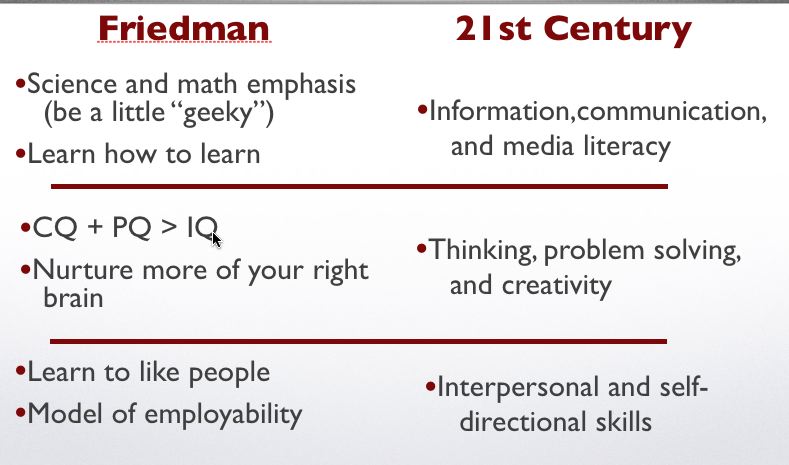Here are my notes from Fred’s excellent keynote. (Now, I’m sitting in his breakout session.)
ITRT Mini Conference
Keynote Speaker: Fred Scott, Manager, Instructional Technology, Chesterfield County Public Schools
7/25/2008
Hardware? Software? No…Let’s Connect With HUMANware
Humanware refers to people. We have been investing in hardware, software and webware, but what about the people? We need to invest in the people in order to improve instruction with technology. We need to connect humanware to school goals, student goals, etc? When our kids leave the school system there is a whole world out there. They may not stay in their community…we have no idea where they will be and what they will be doing. Fred’s framework asks how we connect IRTRs with the humanware: teaching, coaching, training, and learning.
Where does humanware fit in? Alignment for success: are you aware of your technology master plan in your district? professional development; curriculum blue prints; if teachers are only going to teach the SOLs, then we are still behind. The last piece is school improvement so you should be aware of the school improvement plan. How do we get connected with those people?
Data Wise from Harvard University includes 8 steps that begins with organizing for collaborative work and ends with acting and assessing. He has a matrix of tools that will help the team be effective. He aligned the school improvement process with technology tools. The ITRTs need to understand the school data such as the report card.
Training: Rich Allen, Train Smart, 2001 Five Pillars of Training: Engage, Frame, Explore, Debrief, Reflect
Engage: Prepare the mind, you have 5 minutes to establish the connection with an adult; teach people NOT content; teach WITH people to understand the content
Frame: establish relevance, you have one minute to establish relevance, what are you going to help them learn, why is choice good? Because then people can make connections, now you have the next 30 minutes to involve the key concepts
Explore: Learning + Enjoyment = Concepts; people remember the good and the ugly
Debrief: Consolidating learning: how are they going to apply it to the real world?
Reflect: Embed Learning: give them stories.
Quotes Confucious: I hear and I forget, I see and I remember, I do and I understand.
Teaching: connect the goals and objectives, what are we doing and trying to get across
The ABCD method of writing objectives
Audience
Behavior
Condition: how should they be able to do it?
Degree: how much should they be able to do it?
Be SMART:
Specific
Measurable
Achievable
Relevant/Results
Time Dependancy
Discusses Marzano’s strategies: we don’t see it as much as we should
The nine strategies are very powerful: the top three are reinforcing effort and providing recognition, summarizing and notetaking, similarities and differences
New book: Using Technology With Classroom Instruction the Works
He outlines planning question and instructional strategies.
He suggests applying the Madeleine Hunter model: from purpose to closer
Hal Portner, Workshops that Really Work
Showed the A Vision of K-12 Students Today
Coaching: NSDC says that effective coaching means you are with a person one on one. In the coaching model, there is some risk. There are three major levels of risk; are you going to be conservative, moderate or aggressive?
Kimberly Ketterer, “Coach, Nurture or Nudge?” L&L
Coach: there is a paradigm shift from a traditional classroom to one who integrates technology. The adult is now a risk taker who trusts the coach. They are willing to embrace the information and collaborate.
Nurture: The adult is not confident and are still learning skills and applications. But they are willing to try. this adult lacks the confidence and they want to watch you do it. They will say that time is a major problem. They like small achievements.
Nudge: This is the person that is satisfied with the way things are. These people are uncertain and anxious.
Learning: How do ITRTs connect to the learning process to get adults to learn?
Showed a graphic of the basic neuron types: what does it take to help teachers understand the make up of the brain and what’s happening inside. He talked about Howard Gardner and multiple intelligence theory. http://literacyworks.org/mi/home.html You can assess your learning style here.
Marcia Tate: Sit & Get Won’t Grow Dendrites: she talks about adult learning and strategies and activities for how to work with adults.
How do we connect Humanware to Web 2.0 for professional development and learning? He pointed to
• http://www.wetpaint.com
• http://talkingletter.com
• http://www.wonderfile.net
• Center for Learning & Performance Technologies http://www.c4lpt.co.uk/recommended/top100.html
Here’s what ITRTs need to do:
• We have to know the goals and objectives of the school.
• We have to develop collegial relationships.
• We have to recognize that the adults have the expertise.
• We have to align activities with the curriculum.
• We have to help them understand that technology can help improve instruction and delivery.
We must provide our children the best possible learning environments to foster critical thinking, innovations and problem solving to better our society. Fred Scott
ITRTs Lead Out Loud: http://www.leadoutloud.ca
To get results with technology integration, we need to invest in people…nurture, cultivate and develop them to ensure that tools make a difference in learning.
Remember, FRED:
Facilitate
Resources
Educate and
Develop
They did a share fair at his school division for the school board so they could understand the ITRT position.
http://fredwscott.edublogs.com for downloading the presentation
